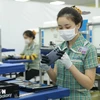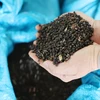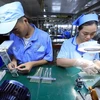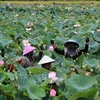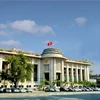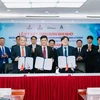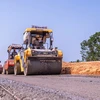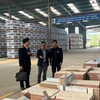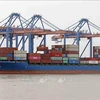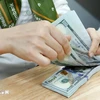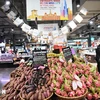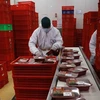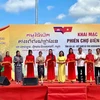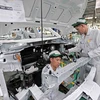The Ministry of Agriculture and Rural Development (MARD) and the People's Committee of Hanoi are implementing a programme to ensure supplies of safe vegetables and meat.
The two organisations believe that this can be achieved by clearly identifying the origin of products, raising the responsibility of producers and businesses as well the general public.
Hanoi currently meets only about 40 percent of demand for vegetables and meat, the rest must be imported from other regions. The city consumes about 800-1,000 tonnes of fruit and vegetables per day and 1,000 tonnes of meat.
Despite a huge demand for healthy, clean produce, vegetables meeting Vietnamese Good Agricultural Practices (VietGap) standards are in short supply in the marketplace.
Moreover, applying GAP creates a number of difficulties in market development, organisation and management due to small-scale and scattered production.
Bui Nhu Y, Deputy Director of the Agriculture and Rural Development Department in northern Vinh Phuc province, said 40 percent of meat was consumed locally and the rest sold to other provinces.
The programme of safe product supply chain for Hanoi is compounded by the absence of companies to buy products, Y said.
In addition, production and consumption of high quality products has faced many difficulties due to loose controls by Hanoi's authorities, Y added.
In some provinces, farmers do not know of any specific demands for Hanoi, they focus on producing, an official from Bac Giang province said.
Nguyen Huy Dang, Deputy Director of the Hanoi's Agriculture and Rural Development Department, said to ensure a supply of safe vegetables and meat for Hanoi, provinces needed to provide information on their supply ability so that city people could handle any transport difficulties.
Hoang Thanh Van, Head of the Animal Husbandry Department, said that each province should set up a chain to supply the best provincial farm produce. This would also help in building a brand name.
Vu Van Tam, Deputy Minister of MARD, said Hanoi and provinces should also enhance cooperation and exchange information about supply and demand to avoid mass production.-VNA
The two organisations believe that this can be achieved by clearly identifying the origin of products, raising the responsibility of producers and businesses as well the general public.
Hanoi currently meets only about 40 percent of demand for vegetables and meat, the rest must be imported from other regions. The city consumes about 800-1,000 tonnes of fruit and vegetables per day and 1,000 tonnes of meat.
Despite a huge demand for healthy, clean produce, vegetables meeting Vietnamese Good Agricultural Practices (VietGap) standards are in short supply in the marketplace.
Moreover, applying GAP creates a number of difficulties in market development, organisation and management due to small-scale and scattered production.
Bui Nhu Y, Deputy Director of the Agriculture and Rural Development Department in northern Vinh Phuc province, said 40 percent of meat was consumed locally and the rest sold to other provinces.
The programme of safe product supply chain for Hanoi is compounded by the absence of companies to buy products, Y said.
In addition, production and consumption of high quality products has faced many difficulties due to loose controls by Hanoi's authorities, Y added.
In some provinces, farmers do not know of any specific demands for Hanoi, they focus on producing, an official from Bac Giang province said.
Nguyen Huy Dang, Deputy Director of the Hanoi's Agriculture and Rural Development Department, said to ensure a supply of safe vegetables and meat for Hanoi, provinces needed to provide information on their supply ability so that city people could handle any transport difficulties.
Hoang Thanh Van, Head of the Animal Husbandry Department, said that each province should set up a chain to supply the best provincial farm produce. This would also help in building a brand name.
Vu Van Tam, Deputy Minister of MARD, said Hanoi and provinces should also enhance cooperation and exchange information about supply and demand to avoid mass production.-VNA
